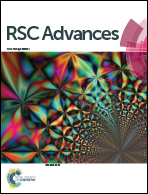Hollow carbon-based nanosystem for photoacoustic imaging-guided hydrogenothermal therapy in the second near-infrared window†
Abstract
Compared with the near-infrared-I spectral window (NIR-I, 650–950 nm), a newly developed imaging and treatment window with a 1000–1700 nm range (defined as the NIR-II bio-window) has attracted much attention owing to its higher spatiotemporal resolution, increased tissue penetration depth and therapeutic efficacy. Herein, we designed a nanotheranostic platform (HC-AB NPs) via loading ammonia borane (AB) into hollow carbon nanoparticles (HCs) for NIR-II photoacoustic (PA) imaging-guided NIR-II hydrogenothermal therapy. Importantly, by exploiting the characteristics of beta zeolite as a hard template and a template-carbonization-corrosion process, the prepared HCs have excellent NIR-II absorption performance and AB loading capacity. With the high biocompatibility of HC-AB NPs, an efficient synergistic anti-tumor strategy has been achieved via high intratumoural accumulation and acid-stimulated H2 release as well as PA-guided precise NIR-II photothermal therapy. The HC-AB NPs as a promising nanotheranostic platform opens a new avenue for high-efficacy NIR-II hydrogenothermal therapy.



 Please wait while we load your content...
Please wait while we load your content...